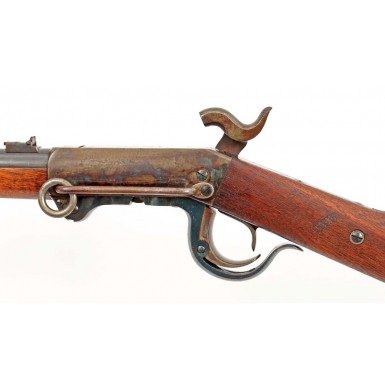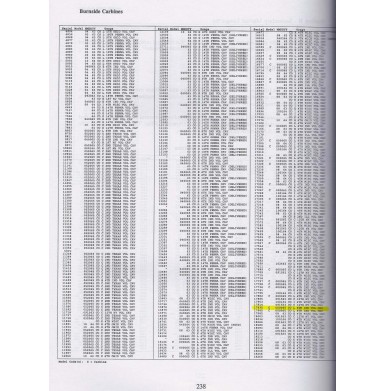6th Indiana Issued Burnside 5th Model Carbine - Excellent
- Product Code: FLA-2159-SOLD
- Availability: Out Of Stock
-
$1.00
This is an outstanding and truly excellent example of one of the styles of breech loading carbine that helped the Federal Cavalry to eventually achieve superiority over the Confederate cavalry during the American Civil War. The Burnside Carbine was the brainchild of future Union General and Rhode Island Governor (as well as a founding member of the NRA) Ambrose Burnside. He was awarded patent # 14490 on March 25, 1856 for the breech loading design. The .54 caliber carbine used a unique tapered cartridge with a foil or brass case and was ignited by a traditional percussion cap. The carbine went through a number of variations (known to collectors as 1st Model, 2nd Model, 3rd Model and 4th Model). The 1st Model Burnside carbine was the first breech loading metallic cartridge carbine to be purchased by the US Ordnance Department, with the first delivery of 200 carbines being made in April of 1856. The most common and most issued version, was the 5th Model Burnside Carbine. The 5th Model carbines were produced from late 1863 through the end of the war, and were officially referred to as the Model 1863 by the Government, even though the receivers of the guns were marked Model 1864! Roughly 55,500 Burnside carbines of all models were produced and delivered to the US government, making it the 3rd most used carbine model of the Civil War. Approximately 43,000 5th models were produced, in their own serial number range. This one has the matching serial number 17935 throughout, placing it in the first half of all 5th model production. The gun was most likely manufactured in the latter part of 1863 or in early 1864. Burnside carbines saw significant use during the course of the American Civil War, with some 53,000 being delivered to the Ordnance Department. A survey of some 185 US military officers conducted between 1863-64 rated the Burnside as follows: 17 “ Best, 125 “ Good, 12 “ Fair, 28 “ Poor and it was rated “worthless’ by 3 officers. This meant that 77% of those officers surveyed had a positive opinion of the gun. Some of the US volunteer cavalry regiments that received the Burnside as part of their supply of small arms were the 1st Michigan, 3rd & 6th Indiana, 5th, 6th & 7th Ohio, 3rd West Virginia, 14th, 14th & 18th Pennsylvania, 14th & 21st New York and the 2nd, 12th, 14th & 16th Illinois and 4th Wisconsin Cavalry. According to the serial numbers compiled by the Springfield Research Service, Burnside #17935 was recorded in the possession of Company L of the 6th Indiana Cavalry Regiment during 1865. The serial number is noted exactly on page 238 of Volume 4 of Serial Numbers of U.S. Martial Arms compiled by the Springfield Research Service.
The 6th Indiana Volunteer Cavalry Regiment was organized on February 23, 1863 from the 71st Indiana Volunteer Infantry. The 71st Indiana Infantry had originally been organized in July and August of 1862, and had fought at the Battle of Richmond (KY), where most of the regiment was captured. After their parole the regiment was sent to Indianapolis, IN where it was reorganized. The regiment next fought on December 27, 1862 at Muldraugh’s Hill (KY), where the regiment was again captured. The ill fated regiment was then paroled again, and reorganized as the
This particular 5th Model Burnside Carbine, issued to Company L, 6th Indiana Volunteer Cavalry is in EXCELLENT overall condition. The metal is smooth throughout with only some very tiny scattered patches of lightly oxidized freckling noted. The barrel retains about 95%+ of the original blued finish, showing some minor fading which has mixed with a smooth, plum brown patina. The receiver retains about 95%+ of the original vivid case hardened colors, with only some very minor fading and darkening. Even the hammer retains about 85%+ of its case coloring, with somewhat more fading and dulling. The lock plate retains about 60%+ case coloring, with fading and toning to a tobacco brown patina, and rear portion of the lock showing the most loss of vivid coloring. The iron butt plate has faded to a more tobacco brown mottled color, but does retain some nice subtle mottling and about 30% of its coloring. The loading lever retains about the same level of case coloring as the receiver. The breech tang and triggerguard tang retain about 95%+ original vivid fire bluing as do the screw heads, which have mostly unmarred slots. The breechblock retains about 90%+ vivid fire blue, with some very minor flaking and fading. The top of the receiver is marked in three horizontal lines: BURNSIDE PATENT / MODEL OF 1864 / 17935. The same serial number is marked on the top of the breechblock as well. The barrel is marked CAST STEEL 1864 forward of the rear sight, and as is typical the mark is somewhat light and poorly struck. The bore rates about EXCELLENT and is brilliantly bright with excellent rifling. There is some very minor scattered pitting present in the bore, as well as some light frosting in the grooves. The lock works crisply and the loading mechanism operates smoothly as it should. The lock plate is marked BURNSIDE RIFLE Co / PROVIDENCE R.I.. The mark is mostly crisp and clear, but the first few letters of both lines appear to have been lightly struck. The cone (nipple) is in excellent, crisp, condition. As previously mentioned, the matching serial number 17935 is stamped on the receiver and the breechblock. Numerous government sub-inspector initials are located on various metal parts throughout the carbine, primarily the letter R, but also some Ws and Ms. The marks are crisp, sharp and legible throughout. The gun retains the original front and rear sights, as well as the original sling ring bar & ring, and the sling swivel on the lower toe of the buttstock.
The buttstock rates NEAR EXCELLENT, with only a handful of minor bumps, dings and handling marks keeping it from rating fully excellent. The stock is solid and without any breaks, chips or repairs. There is a very short and tight surface grain crack on the reverse of the buttstock (well documented in the pictures below), but this is not structural, is only a surface grain crack, and in no way detracts from this wonderful carbine. A very crisp & fine inspectors cartouche is present on the left side of the wrist. They are the script initials RKW, which may be the mark of Ordnance Department Captain Robert Henry Kirkwood Whiteley, who worked from 1838 to 1874. His primary mark was a four letter RHKW cartouche, but a handful of Civil War era carbines are known with only the RKW mark (mostly 5th Model Burnsides and Gwyn & Campbell carbines), which were likely inspected by Whiteley as well. A small three letter mark, which appears to read MSF or possibly MSP is also stamped into the top of the stock, forward of the buttplate tang. This same three-letter inspection mark is present in the bottom of the forend, just in front of the receiver. The forend is in similar condition to the buttstock, showing only some minor bumps, dings and handling marks, indicative of carry across the pommel of a saddle. It is also solid, without and breaks, cracks or repairs. The forend is a slightly lighter color than the buttstock, but that is simply a variation in the different pieces of wood used to make the two pieces.
Overall is a really exceptional example of a carbine that is rarely found in much better than fine overall condition. Finding a Burnside with this level of case coloring is not at all common. The huge amount of original finish and lovely wood combine to make really attractive Burnside that is very impressive to look at. Even more amazing is that we know what regiment it was serving with during the last months of the war. Typically, guns with identifiable unit history are in much rougher condition and show major use and wear. This one shows some minor wood wear from carry and use, but is in an outstanding state of preservation. It would be very difficult to find a better example of a 5th Model Burnside, and I would doubt a better regimentally identified Burnside will appear on the market any time in the near future.
SOLDTags: 6th, Indiana, Issued, Burnside, 5th, Model, Carbine, Excellent,










